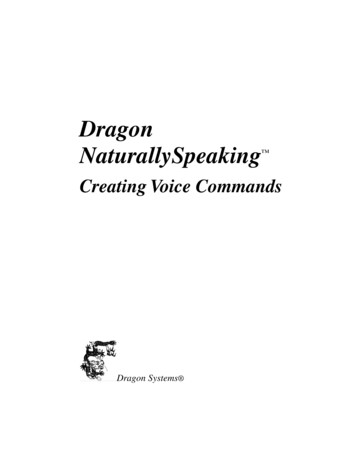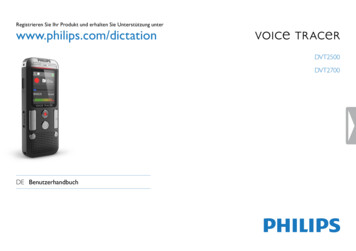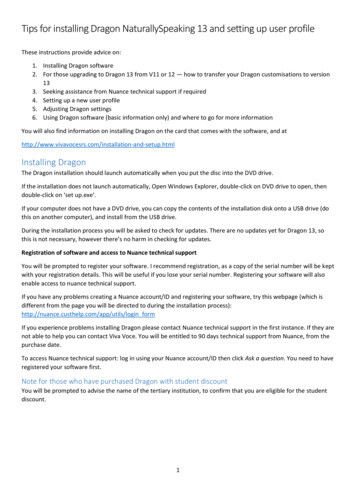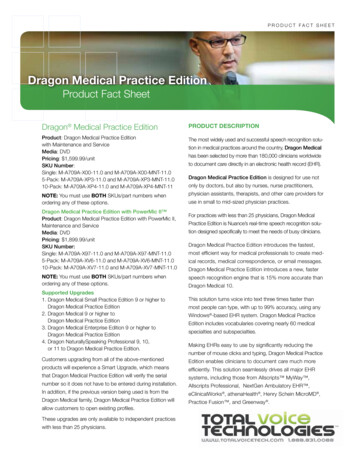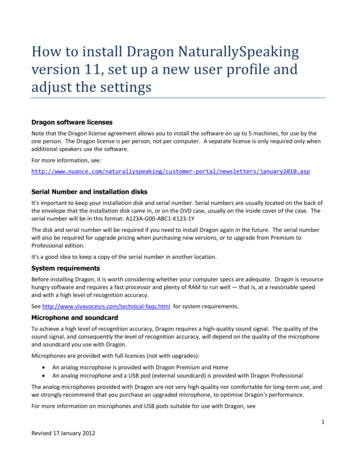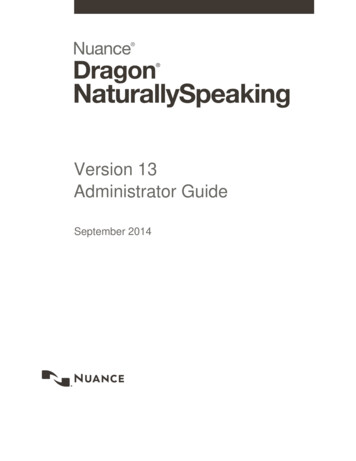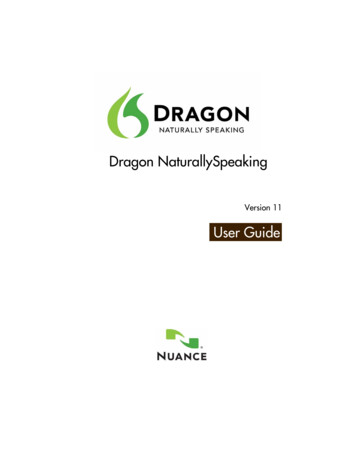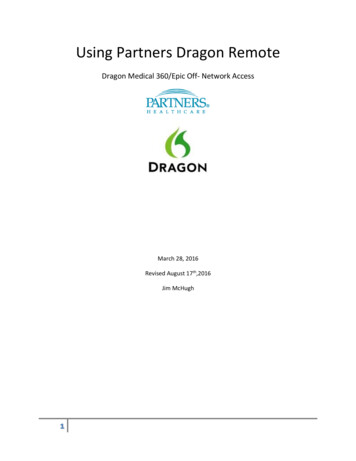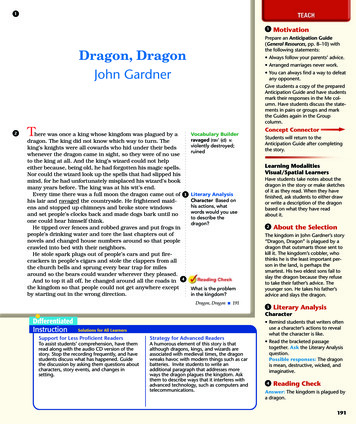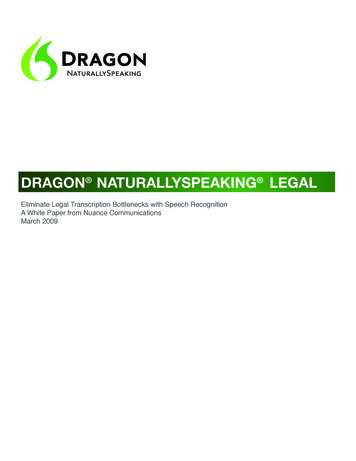
Transcription
Dragon NaturallySpeaking legalEliminate Legal Transcription Bottlenecks with Speech RecognitionA White Paper from Nuance CommunicationsMarch 2009
DRAGON NATURALLYSPEAKING - LEGALIntroductionThe time and cost involved in documenting case and client information, contracts, briefs and other legal materials is staggering. Traditional reliance on administrative support staff and outside transcription services drags down productivity andeats into profits. Many law firms and corporate legal departments are rethinking their internal practices to stay competitive: How can you reduce staffing costs, make staff more productive, and steer them toward more billable duties? Why are you paying a qualified legal secretary to type a document when he or she could be doing more productive work that leverages a stronger skill set? How can you improve transcription turnaround time to eliminate the bottlenecks that hamper efficiency andweigh down service?Imagine detailed briefs and contracts created entirely by voice in a fraction of the time. Consider the efficiencies gained byusing support staff to proofread documents instead of keying them in from scratch.Thousands of legal professionals now leverage speech recognition technology to dramatically reduce the time it takes tocreate everything from briefs and contracts to case documentation and correspondence.Law firms and legal departments can deploy speech solutions broadly to speed document turnaround, reduce transcription costs, and streamline repetitive workflows – without having to change current business processes or existing information systems.This white paper discusses some of the legal profession’s most pressing cost and productivity issuesand how speech recognition can: Speed Document Creation: You can turn your voice into text with up to 99 percent accuracy using virtually anyWindows-based application. Speech recognition delivers results three times faster than most people type. Eliminate Document Development Bottlenecks: Streamline the editing and correction process with speechrecognition to dramatically decrease turnaround time and reduce dependencies on support staff. Lawyers, legalsecretaries and paralegals can become more productive if they’re free to focus more on billable work. Increase Efficiency and Profitability: A law firm – large or small – can increase billings without increasing staffsupport costs, just as a corporate legal department can become more efficient and effective in their daily work.Law firms and legal departments can deploy speech solutions broadly to speed document turnaround,reduce transcription costs, and streamline repetitive workflows – without having to change currentbusiness processes or existing information systems.How Does Speech Recognition Software Work?Speech recognition software products, such as Dragon NaturallySpeaking Legal from Nuance Communications, use thehuman voice as the main interface between the user and the computer.While relatively simple to use, speech recognition software is a highly sophisticated technology that leverages “languagemodeling” to recognize and differentiate among the millions of human utterances that make up any language. Usingstatistical models, speech recognition programs analyze an incoming stream of sound and interpret those sounds ascommands and dictation. This process of interpretation is called speech recognition, and its success is measured by the 2009 Nuance Communications, Inc. All rights reserved.- Page 2 -
DRAGON NATURALLYSPEAKING - LEGALpercentage of correct interpretations.Dragon NaturallySpeaking is an example of a speaker-dependent speech recognition system.Dragon creates a voice profile for each user of the system that contains information about the unique characteristics ofeach person’s voice along with a customized set of words, known as a vocabulary, and user-specific information includingsoftware settings and personalized voice commands.When Dragon users create and train their user profile, Dragon starts with models based on the analysis of thousands ofvoices and texts, which are then customized for the way they sound (acoustic model) and the words and phrases they use(vocabulary and associated language model). This approach accommodates users with varying accents and speech patterns. The software employs the customized user profile to guess the words spoken. Every time an individual uses Dragonand corrects his vrecognition errors, the software updates his user profile to enable better recognition accuracy over time.(See Fig.1)Fig. 1 How Speech Recognition WorksEven those who have evaluated speech recognition software in the past may want to consider taking another look at thetechnology. Recent advances in both the software itself and the hardware it runs on have yielded significant increases inperformance, accuracy, and ease of use. The net result is that lawyers can create contracts, briefs, and emails three timesfaster than typing or traditional transcription. In fact, thousands of legal professionals use speech recognition today to getmore done in less time.Each organization, and even the individuals within each organization, use speech recognition for different purposes,based on their responsibilities, workflow, preferences, and other applications used. Speech recognition users include partners, associates, corporate counsel, judges, legal researchers, court reporters, law students, paralegals, mobile professionals, people with disabilities, transcriptionists, assistants, and other support staff.Where is speech recognition in use in legal environments today? Creating documents, including contracts, briefs, motions, notices, pleadings, memos, etc. Managing email Summarizing documents Streamlining third-party transcription Increasing accessibility (helps with injuries, dyslexia, etc.) Boosting general office productivity 2009 Nuance Communications, Inc. All rights reserved.- Page 3 -
DRAGON NATURALLYSPEAKING - LEGALSpeed Document TurnaroundLaw firms rely heavily on expensive paralegals, legal secretaries, or outside services to transcribe the many documentsrequired for legal proceedings—client memos, contracts, motions, briefs, discovery and deposition summaries, and more.There are essentially two approaches to document creation in place today, and as case volumes and administrative costscontinue to grow, each approach presents a unique set of drawbacks: Third-party transcription: a lawyer dictates into a telephone or digital recorder, and the audio is sent to an outsidetranscriptionist; alternatively, the recording may be sent to an in-house transcriptionist, secretary or legal assistant. Outsourced transcription is simply too expensive and time consuming, slowing down proceedings, impacting client satisfaction, and cutting into profits. Although in-house transcription may be more cost-efficient than outsourced efforts, there isstill a lengthy and unproductive back-and-forth of review cycles with support staff. (See Fig.2) Direct input: the lawyer types the information himself. Some individuals can’t type, or prefer not to, either because theyare untrained as typists, have a disability, or wish to prevent the development of a repetitive stress injury. Firms and corporate departments with limited staff require attorneys to create their own accurate documents under tight deadlines. Thismay even be the case when an in-house transcription process is in place since many attorneys work late into the night –long after support staff has gone home.Using Traditional TranscriptionTotal Time: 2 – 6 hours depending on workloadUsing Speech RecognitionTotal Time: 30 minutes – 1.5 hours depending on workload 2009 Nuance Communications, Inc. All rights reserved.- Page 4 -
DRAGON NATURALLYSPEAKING - LEGALDictation is Three Times Faster Than TypingThe speed, accuracy, and ease of use of today’s speech recognition systems deliver an efficient alternative to traditionalapproaches for document creation. Simply put, most people can talk faster than they can type. Speech recognition enables legal professionals to create electronic documents at speeds of up to 160 words per minute — three times fasterthan typing. Users just talk to their computers and their words instantly appear in the full Microsoft Office suite, as wellas Microsoft Internet Explorer , Corel WordPerfect , and virtually all other Windows-based applications, includingwidely-installed case and practice management programs.Rather than use a standard headset microphone, lawyers may be more comfortable with a Bluetooth headset. Using aBluetooth headset with select speech recognition systems delivers the same great dictation results – without the wires. Inthis way, lawyers not only have their hands free to browse texts or notes on their desks, but they can also cross the officeto consult references as necessary while continuing to dictate.How Do Lawyers Benefit from Speech Recognition?Transcription WorkflowSpeech recognition is particularly useful for attorneys and in-house counsel who are feeling the productivity pinch of theendless dictate - transcribe - review - edit cycle. Attorneys who are already dictating documents for others to transcribecan continue to do so without having to change their workflow. But with speech recognition the dictation is automaticallytranscribed, jumpstarting the interaction with the legal secretary or assistant responsible for transcription.The speech recognition system routes the transcript text file and/or the synchronized audio file to a legal assistant orsecretary. Instead of transcribing from scratch, the assistant will open the transcript, listen to the associated dictation whilereading the text on screen, and make corrections or edits. Any edits made by the assistant improve the speaker’s profileso that the speech recognition system will improveBob Kohn, a managing partner at Bromberg andrecognition accuracy over time.Sunstein, a law firm in Boston, initially started usingDragon after a repetitive stress injury made typing tooUsing speech recognition software to input text cansubstantially reduce the turnaround time over tradition- painful. Upon seeing the immediate productivity gainsal transcription. If transcription is produced in-house,Bob was realizing, other lawyers within the firm startusing speech recognition software frees up supported using Dragon, too. By allowing attorneys to dictatestaff for more productive tasks. If transcription isoutsourced for correction, this can significantly reduce their own documents, emails and memos — day ornight — Dragon has saved the firm tens of thousandscosts.of dollars in administrative overtime while improvingA firm or corporate legal department may use seservice to clients.lect speech recognition programs, such as DragonNaturallySpeaking Legal, to create an “auto-transcription agent”. This tool allows users to have the system automaticallymonitor a folder for incoming audio files. As that audio file is received, the system automatically converts the file into a textfile. The agent can be set to create an audio file associated with the converted text so that correctionists have the ability toplayback the audio while they read through the documents.While creating the dictation, the attorney may also choose to use Dragon’s Voice Notations feature, which allow the userto make “side comments,” such as specific instructions, that can be saved as part of the recorded dictation but do notappear as part of the dictated text. This recording may be passed along to a legal secretary who will use the originator’sDragon profile to import the recording, convert it to text, and then make corrections. 2009 Nuance Communications, Inc. All rights reserved.- Page 5 -
DRAGON NATURALLYSPEAKING - LEGALBut Is It Accurate?Leading speech recognition tools can offer up to 99 percent accuracy right out of the box. Using specialty vocabulariescan heighten accuracy even further. Some speech recognition software programs include a legal vocabulary – incorporating Latin and French law terms, reporter names, and abbreviations in addition to the standard business vocabulary – andcan automatically recognize and format federal, regional, and state citations. For certain programs, specialty legal vocabularies can also be created in-house or purchased from third-party sources.Every law firm uses specific names, terminology, acronyms, or other vocabulary unique to its specialty or its client base.These unique terms are frequently used in court papers, correspondence, and other legal documents. To boost accuracyand further speed document turnaround, speech recognition software also allows legal professionals (or those who workwith them, such as assistants, IT administrators, or trainers) to: Add new words or customize the vocabulary with employee names, acronyms, and specialized terminology frequently used in their firm or department Delete entries that could cause acoustic ambiguity (such as competing spellings) Indicate precisely how items should be capitalized and formatted, including alternate written forms for variouscontexts Analyze an individual’s written documents to update the user profile based on writing style and words usedIf an organization uses particular names or terminology with a high degree of frequency, customizing the vocabularyacross the entire enterprise can increase recognition accuracy so users and their support staff spend less time correctingerrors.Speech Recognition Systems Can Make “Smart” Choices on Spelling,Capitalization, and More by Adapting to Context With Dragon, law firms can customize vocabulariesto increase recognition accuracy rates. As a result, users spend less time correcting errors. Userscan customize “spoken forms” to yield specific written forms of words and phrases, such as “versus”to appear as “vs.” or “figure” to appear as “Fig.” Or perhaps a key contact at a practice’s top client isnamed John Shaffer. The firm may want to consider deleting the other common spellings of the nameShaffer (Schaeffer, Schaefer, Shafer, etc). This way, Dragon will choose the intended spelling formore accurate dictation of correspondence and legal documents.Workflow AutomationAn enterprise deployment of speech recognition allows legal professionals to go beyond dictation to accomplish routinetasks more quickly and efficiently. One approach is to cut down on the number of steps it takes to complete a given task— without changing established business processes.Navigate Applications by VoiceSpeech recognition software enables users to command and control the computer desktop by voice. Virtually any menuitem or dialog box can be controlled hands-free. Users can edit and format their work, launch applications and open files,or cut-and-paste documents. In other words, speech recognition helps to speed up routine tasks on the PC. 2009 Nuance Communications, Inc. All rights reserved.- Page 6 -
DRAGON NATURALLYSPEAKING - LEGALMany legal applications can be easier to use and more effective when deployed in conjunction with speech recognition.Searches, queries, and form filling are all faster to perform by voice than keyboarding. Document management, document assembly/automation, and case and practice management software programs are all highly conducive to control byspeech. Tasks such as text and data entry can be completed by voice in most of the programs without any customization.Other functions can easily be performed using macros (see below).Managing EmailSince managing email takes up an increasing amount of everyone’s workday, speech recognition software can be used tocreate, navigate, send, and respond to email by voice using popular programs like Microsoft Outlook or Lotus Notes. Inaddition, some speech recognition programs contain text-tospeech technology that allows users to have their email documents read aloud, which enables them to complete other tasks while listening to their email.Work on the Web by VoiceToday’s speech recognition programs make it easier than ever for lawyers and staff to search the Web, access information, and navigate Web pages. This includes not only the public Internet, but also private Intranets and other HTML interfaces.Consolidate Multi-Step Processes into a Single Voice CommandDragon Voice ShortcutsMost speech recognition programs allow users to speak standard commands that prompt the computer to perform an action. For example, the user says, “start WordPerfect,” and the PC launches WordPerfect. The more advanced speech recognition programs, such as Dragon NaturallySpeaking Legal, also enable users to collapse multiple tasks into single voicecommands. For example, using the Dragon Voice Shortcuts for Email feature, a lawyer could simply say, “Send email toClient XYZ” and Dragon will launch the user’s email program, create a new email and put the name(s) the lawyer said intothe “To:” box. Users can also search the Web or their desktop with a simple voice command such as, “Search the Web forglobal warming articles,” or “Find email about the Robinson appeal.”Boilerplate CommandsLawyers and the staff who support them spend a considerable amount of time creating and filing documents — many ofwhich share standard elements. As a result, many legal secretaries and assistants find themselves entering the sameinformation into these documents time and time again. Users can create text blocks—including commonly used phrases,paragraphs and even graphics—and insert them into documents or emails using a single voice command for faster, easierdocument creation. These custom commands can also contain variable “voice fields.” In this way, a single voice commandcreates a complete document that can be customized by navigating through each field to fill in variable information (e.g.,the name of a client or a fee on a standard client letter or contract template).Macro CommandsRepetitive tasks, such as data entry or form filling, can be sped up by using speech. In many cases, users who are unfamiliar with complex software programs are more comfortable “telling” the computer what to do rather than trying to masterthe interface. Macros can be created to enable users togo from field to field by voice, or to perform a sequenceAutomate Processes with Macro Commandsof keystrokes or mouse movements. Even skilled typistsRepetitive tasks take far less time when they’reare often slower at entering numbers and letters. Spreadautomated with simple voice commands. Withsheets can be created and edited using voice commands.Dragon NaturallySpeaking Legal, a set of abbreviAccounting and time billing software can also be conated instructions can be given to the computer totrolled by voice.For example, legal professionals – or more typically the ITcomplete repeatable tasks that would normally takemultiple keyboard combinations and mouse clicks. 2009 Nuance Communications, Inc. All rights reserved.- Page 7 -
DRAGON NATURALLYSPEAKING - LEGALdepartments that support them – can use Microsoft Visual Basic to build a single voice command that saves a contract,emails it to a standard list of recipients at the client company, and prints out a hard copy at both corporate headquartersand the appropriate regional office – all with a single spoken command such as “Complete Contract.”Repetitive tasks take far less time when they’re automated with simple voice commands. By simplifying multi-step processes that legal staff performs dozens of times a day, workflow automation can deliver significant productivity gains,especially when multiplied across hundreds of workers enterprise wide.Increasing Productivity on the GoMany attorneys spend a significant amount of time traveling from location to location — client visits, depositions, courthearings, and more. Since most of these individuals already work long hours, it’s important that they use their time productively — no matter where their jobs take them.Speech recognition enables attorneys and other legal professionals to increase their productivity during travel time orwhen away from the office by dictating into a digital voice recorder or other handheld device for automatic transcriptionwhen the user returns to his PC. An enterprise deployment of speech recognition allows users to export their user file viathe network or a portable storage device for use on another computer or laptop so they can take advantage of speechrecognition anywhere, at anytime.This mobile productivity tool ensures that time spent on the road or off site does not mean even later nights at the officecatching up on work. Legal professionals can use in-vehicle and other formerly unproductive time to dictate notes, reports,and other documents — safely and accurately. As a result, they are able to turn around documents quickly for improvedclient service and increased focus on billable tasks.A real estate attorney asserts that Dragon NaturallySpeaking Legal has dramatically changed the wayhe practices law. Whether he is in the office or on the road, Dragon enables him to zip through workthat he formerly delegated to a paralegal for transcription. He is able to generate real estate documents, including policies with specific exceptions, from his office, car, or laptop. When he has severalletters to compose, he uses Dragon to dictate drafts — with instructions included as voice notations— which he saves in a special file on his computer for follow-up by his paralegal. This approach enables him to focus more of the firm’s time on billable tasks for bottom-line results.Managing a Desktop DeploymentA successful speech recognition deployment requires careful attention to user expectations, training, and customization.Some organizations choose to manage their own speech recognition installation, customization, and training, but mostprefer to outsource this work to the software manufacturer, a system integrator, or speech recognition value added reseller(VAR).Carefully review the system requirements for the speech recognition software you will implement. Speech recognition 2009 Nuance Communications, Inc. All rights reserved.- Page 8 -
DRAGON NATURALLYSPEAKING - LEGALsoftware is processor intensive, and, generally speaking, the faster the processor, the better the performance. Users whowish to have multiple applications running at the same time will also benefit from having more RAM on their system.The computer’s sound card is another factor that can affect performance. Speech recognition programs require a soundcard that will accurately process the electrical charges that your voice creates when you speak into the microphone. Staticor electrical interference will make it difficult or impossible for users to achieve good speech recognition accuracy. In general, speech programs require a high-quality 16-bit sound card. Software performance can also be impacted by the qualityof the microphone used. Speech recognition requires a high-quality, high-level speech signal. Noise-canceling microphones, such as those shipped with most speech recognition programs, can help to block out high ambient noise levels.User Expectations and TrainingWhile most speech recognition systems can deliver high-performance dictation and application control capabilities rightout of the box, upfront professional training and customization will enable lawyers and support staff to realize more significant productivity gains and cost savings and maximize their return on investment. Initial training speeds up the learningcurve, instills confidence in users, reduces support costs, promotes the success of a pilot program, and maximizes yourinvestment. Ongoing training support can familiarize staff with advanced features and functionality for continuous productivity improvements.In addition, setting realistic user expectations has a critical impact on the success or failure of the speech recognition program. While speech recognition enables organizations to automate workflows without disrupting existing processes, thereis still a component of change as employees adopt the new technology and transition to the new approach of dictation vs.typing.Professional training can facilitate the change management process, helping to speed and ease the organization’s transition and drive higher user adoption rates. Most attorneys who are familiar with dictation will find it easy to adopt speechrecognition software. However, they may be used to mumbling or garbling words and expecting a transcriptionist to interpret what they are saying. The quality of the “human sound signal” is just as important as the quality of the sound card.CustomizationAn investment in vocabulary customization can also deliver big payoffs. By customizing the system’s vocabulary at thestart of an engagement, enterprises can obtain remarkably accurate recognition results from the first day of deployment.In addition, the speech experts at Nuance or members of the Value-Added Reseller community can work with an organization up front to understand its processes and identify opportunities for increasing efficiency, then create and delivervocabularies as well as sets of custom commands and macro commands that can speed the execution of repetitive, multistep tasks to deliver big productivity benefits when shared across enterprise users. While text and step-by-step macroscan be created with no knowledge of programming, more complex macros require advanced scripting using MicrosoftVisual Basic. Some firms or legal departments have IT departments that can create such macros for Dragon users, aftersome instruction on the Dragon’s specific functions; alternatively organizations may wish to enlist assistance to developsome or all of the initial commands, and a few “super-users” are taught.Network AdministrationInstalling and managing a desktop dictation solution from a central network location enables system administrators to: create and manage installations and user profiles over a network distribute customized vocabularies and commands automatically control settings estrict access to specific features on a user-by-user basis 2009 Nuance Communications, Inc. All rights reserved.- Page 9 -
DRAGON NATURALLYSPEAKING - LEGAL automatically synchronize updates and changes via a variety of communication protocols perform system backupsAdvanced speech recognition systems offer administrative tools that enable enterprise users to share custom vocabularies and macros across multiple users. For example, the administrator can use vocabulary enhancements made by oneindividual in her own profile and let other users benefit from these enhancements . Updates of shared vocabularies can bepushed to multiple end-users automatically.This eliminates the time-consuming task of entering new words and pronunciations one at a time on each end-user’smachine. A centralized network allows multiple users to discover best practices and quickly and easily share them acrossthe user community. It also fosters the creation of an Intranet “Dragon Information Center” to post specific demos, tips &tricks, FAQs, sample word lists and commands, a “suggestion box” and more.Justifying the Expense“I have used Dragon NaturallySpeaking since 1995 and now almost all of my written legal work is accomplished through voice dictation instead of typing,” said attorney Joseph Field. “It is a great productthat has saved me an incalculable amount of time.”Enterprise speech deployments consist of several components: Client software Professional Services (planning, installation, customization, training and support) Audio peripherals (headsets, digital recorders, wireless microphones) Enterprise resources (Server & storage resources, back end system integration, end-user support, data andprofile maintenance)Personnel-Related CostsAn ROI evaluation for speech recognition begins with a review of the intrinsic loss of personnel working on transcriptiontasks instead of on primary tasks, based on the average hourly salary. But consider, too, the cost of other personnel-related items: Estimated annual cost of noncompliance with American Disabilities Act in computer operations (legal fees, lawsuit awards/settlements, lost business opportunities, etc.) Cost of computer-related RSI and similar claims Estimated annual loss of personnel productivity from RSIRepetitive stress injuries are the single largest job-related injury and illness problem in the United States, as well as otherareas of the world. While most RSI sufferers are able to find appropriate treatment and return to their positions, some become permanently disabled and are never able to use their hands to operate a computer again. Speech recognition helpsto prevent injury before problems arise and can also help employees return to work sooner, reducing worker’s compensation, medical and replacement labor costs. 2009 Nuance Communications, Inc. All rights reserved.- Page 10 -
DRAGON NATURALLYSPEAKING - LEGALReturn on InvestmentIn most cases, enterprises that purchase advanced speech recognition tools such as Dragon NaturallySpeaking Legalrealize improved productivity and return on investment (ROI) almost immediately.What makes this rapid ROI possible? It’s easy to use. For a sophisticated tool, Dragon is remarkably easy to use —allowing most users to be up andrunning in less than 15 minutes — leading to high adoption rates with minimal training and support costs. It saves time. Dragon enables users to create documents and emails three times faster than typing. Macrosautomate and streamline repetitive manual processes for productivity increases of up to 300%. It’s accurate. With recognition accuracy rates of up to 99%, Dragon allows users to quickly create detailed andaccurate documents – without any spelling errors.Attorney Joseph Fields took a hard look at what he was spending and found that rising administrative costs were eating away a large chunk of his firm’s profits. Like most practices
Dragon NaturallySpeaking is an example of a speaker-dependent speech recognition system. Dragon creates a voice profile for each user of the system that contains information about the unique characteristics of each person's voice along with a customized set of words, known as a vocabulary, and user-specific information including
